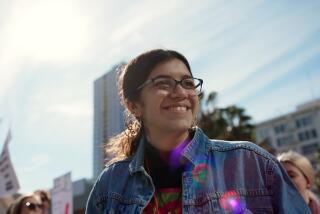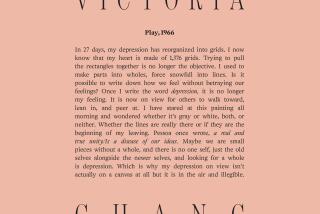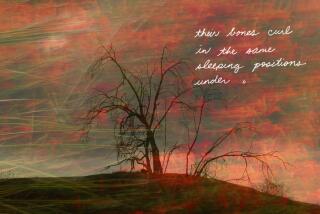Mary Ellen Solt, 86; a leader in the concrete poetry movement
Mary Ellen Solt, a poet and poetry critic who often arranged words on the page in a visual graphic, resulting in such works as “Forsythia,” a poem that looks like a flowering shrub, has died. She was 86.
Solt died June 21 at Henry Mayo Newhall Memorial Hospital in Santa Clarita after suffering a stroke, her daughter Susan said.
She was a leader in the concrete poetry movement that emerged in the 1960s. It held that the visual effect of letters, words and phrases on a page is an important element in poetry.
A poem is “an object in its own right for its own sake” that “communicates first and foremost its structure,” Solt wrote in her book “Concrete Poetry: A World View,” published in 1968.
She traced the history of the movement from 17th century English sonnets with their exacting form, through the stream-of-consciousness writing of symbolist poet Stephane Mallarme in the 19th century and Irish novelist and poet James Joyce in the 20th, to the free-association poetry of e e cummings. All three writers experimented with the arrangement of words on the page.
Solt also credited her friend and poet William Carlos Williams as a mentor, because he aimed to “revitalize a language divorced from meaning,” she wrote in her poem “Words and Spaces.”
“Forsythia,” her most popular work, is the clearest example of her concrete verses. The title appears at the bottom of the page. Each letter has a different word “growing” out of it to form a “branch” of the plant.
The poem speeds along on free association: “forsythia out race springs yellow telegram hope insists action.” The work was first published during the social upheavals of the mid-1960s and suggests that the yellow blossoming shrub announces change.
Although concrete poetry never received the attention of the Beat poetry that came before it, poets from Western Europe to Latin America were part of the movement.
The Scottish poet Ian Hamilton Finlay once wrote a love poem, titled “Au Pair Girl,” that was arranged on the page in the shape of a pear.
Poetry critics gave concrete poetry a mixed review in the 1960s. “One’s first impression ... is of trivial though perhaps charming playfulness,” wrote M.L. Rosenthal in his 1967 book, “The New Poets, American and British Poetry Since World War II.”
He compared concrete poetry to “amusing wallpaper for intellectuals.”
In their defense, however, he gave the concrete poets credit for raising the basic question, “What constitutes poetic power?” from a new perspective.
In recent years, the movement has been reevaluated as a forerunner to digital poetry, which is composed on a computer, Marjorie Perloff, a poetry critic on the faculty at USC, said in an interview this week.
Digital poets choose their type font, add color choices and arrange the words on the screen in the spirit of the concrete poets, “who felt that poems are to be not just heard but seen,” Perloff said.
Solt was born Mary Ellen Bottom on July 8, 1920, in Gilmore City, Iowa. She gradated from what was then Iowa State Teachers College and earned a master’s degree in English literature at the University of Iowa.
She met her future husband, Leo Frank Solt, at teachers college. The couple married in 1946 and had two children.
After graduating from teachers college, Solt taught high school English for some years and then joined the faculty of Indiana University, where she taught comparative literature until she retired in the early 1990s.
She moved to Los Angeles in 1996.
Throughout her career, Solt’s poems were published in poetry magazines and anthologies.
Besides Susan, a faculty member in the theater department at the California Institute of the Arts, Solt is survived by another daughter, Catherine of New York City, and a sister, Jean Peterson, of Iowa City, Iowa. Her husband died in 1994.
Services are pending.
More to Read
Sign up for our Book Club newsletter
Get the latest news, events and more from the Los Angeles Times Book Club, and help us get L.A. reading and talking.
You may occasionally receive promotional content from the Los Angeles Times.







